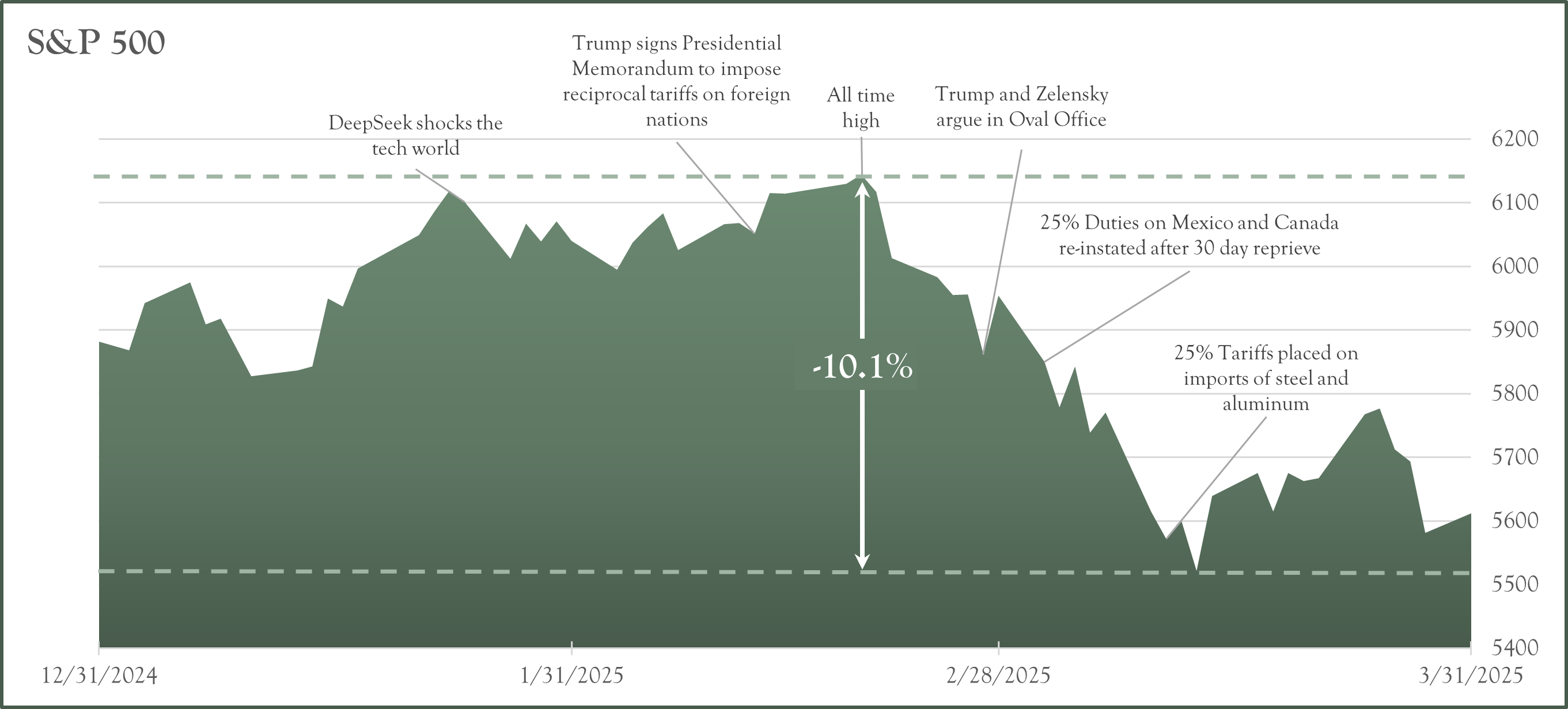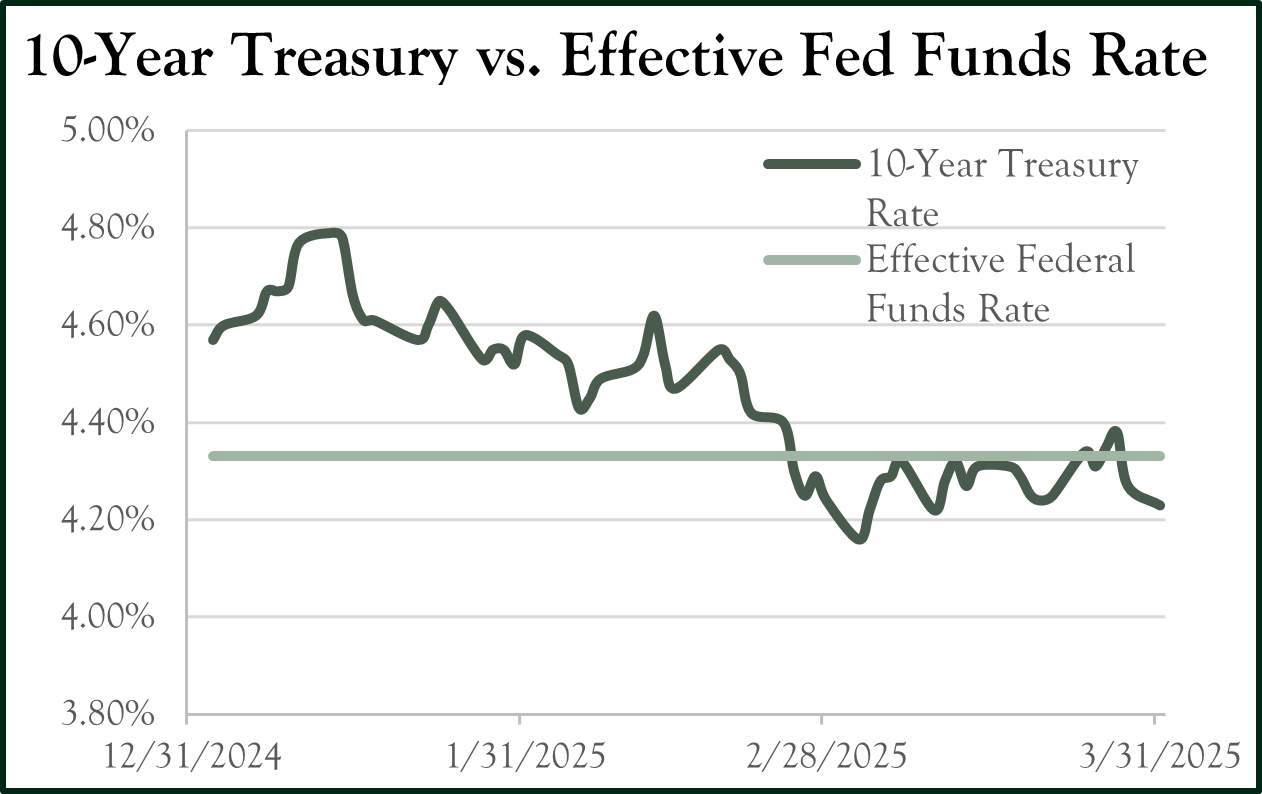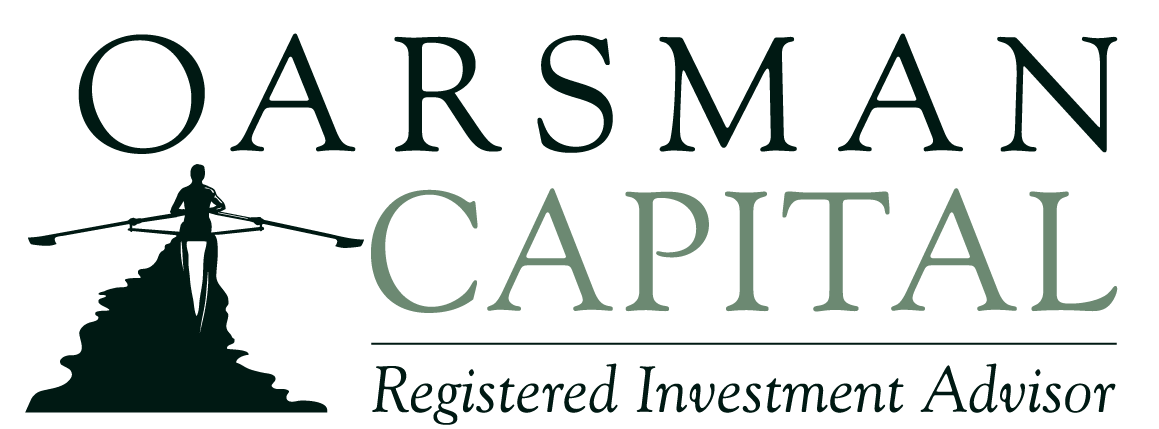1Q 2025 Review and Outlook
The first quarter of 2025 exhibited a stark contrast in market behavior, beginning with a continuation of the late-2024 rally, peaking at an all-time high in mid-February before sharply reversing lower. The S&P 500 declined more than 10% from its high before ultimately finishing the quarter down 4.3%. This was the index’s first quarterly decline and 10% correction since Q3 2023. Among U.S. large-cap sectors, Energy, Materials, and Utilities led with solid gains, while Technology and Consumer Discretionary lagged. Small-cap stocks fared worse, nearly doubling the decline of their large-cap counterparts. Notably, international markets—buoyed by a shift away from “U.S. exceptionalism”—managed several weeks of outperformance relative to the S&P 500, ending the quarter with positive returns.
The decline in U.S. markets was primarily driven by uncertainties surrounding new tariff policies under the Trump administration and growing economic concerns. (Note: as many readers know, this uncertainty has been exponentially exacerbated with the hard tariff numbers revealed on April 2nd.) The ever-changing tariff proposals have shaken the confidence of consumers, investors and CEOs alike. Consensus estimates for the first quarter Gross Domestic Product (GDP) are still in positive territory but have declined since the beginning of the year.
Fixed Income posted gains as longer-term yields gradually declined during the quarter. The Bloomberg U.S. Aggregate Bond Index was up 2.5% while municipal bonds were generally unchanged. Broader commodities also rose with gold surging over 17%, leading all major asset classes.

What drove the stock market?
“What’s Changed?” is a simple explanation of what happened in S&P 500 during the most recent period but does not necessarily explain why the market moved. Let’s explore the “why” by looking at three individual components that shape market changes.

Dividend Yield: The most stable of the three factors. Dividend yields were approximately 0.3 percent this quarter.
Change in Earnings Expectations: Over the long term, earnings drive stock prices. This quarter, earnings expectations rose by 0.2 percent, continuing the trend of positive changes. Notably, expectations for 2025 project a solid 14 percent increase over 2024 earnings. While adjustments are likely along the way, we remain optimistic that double-digit earnings growth for 2025 will materialize.
Change in Valuation (Price/Earnings ratio): The Price/Earnings (P/E) ratio measures how investors value a company’s earnings. Over longer periods (spanning multiple quarters or years), a rising P/E ratio generally aligns with rising earnings. However, over shorter-term periods, such as this three-month snapshot, the two can diverge. This quarter, the P/E ratio increased by 1.9 percent, while earnings expectations edged up just 0.2 percent. This suggests slightly more optimism from investors than current fundamentals warrant. Our view is that stock market participants are focusing more on long-term prospects than usual.
What drove the bond market?
During the quarter, the Federal Reserve paused its rate-cutting cycle with Chair Powell affirming at the most recent FOMC meeting that the Fed is in “no hurry” to cut further without more data. The latest reading of inflation (as measured by the Consumer Price Index) came in at 2.8%. This is a significant improvement from the 9.1% reading we saw in June 2022, yet well above the Fed’s stated target of 2%. The Fed appears reluctant to lower rates any further for fear of triggering another uptick in inflation.
Adding to the lingering inflation issue is the Trump administration’s dramatic and volatile tariff policy. This has investors worried about the future growth of the U.S. economy as evidenced by the decline in the 10-year Treasury bond yield from 4.57% at the start of the quarter to 4.23% at the end.
Within the quarter, we also witnessed widening credit spreads. Credit spread is the additional yield investors require over the risk-free rate. While this spread is coming off historically low levels, an increase can be a “canary in the coal mine” indicator of deteriorating economic health.
The Federal Reserve cut its benchmark interest rate twice in the quarter, lowering the Federal Funds rate to a range of 4.25 to 4.50 percent. Despite the Fed cutting short-term rates, however, the yield on the 10-Year Treasury rose from 3.8 percent to over 4.5 percent. There are several possible explanations for this upward move. To begin, inflation has remained stubbornly above the Fed’s target of 2.0 percent. Fed Chairman Jerome Powell has stated that the Committee is closely watching for signs that inflation could be re-accelerating. Higher inflation in the economy has an upward bias on interest rates and rates drifting higher could be an indication that the market is pricing in this possibility. If that is the case, the Fed would be forced to pause (or possibly reverse) their current rate-cutting cycle. Another possible explanation is the incoming administration’s focus on lowering taxes and deregulation - both potentially expansionary policies. The re-rating of growth expectations upward translates into higher long-term interest rates as bonds are sold (lower price, higher yield) in favor of higher return-potential equities. Either reason, or a combination of the two, leads to higher rates in the future.

Outlook
As we look ahead to the rest of the year, uncertainty remains at the forefront. At the time of this writing, we are in the process of unpacking the tariffs levied on most of the world on April 2nd. While the ultimate impact of these tariffs is unknown, they do very little to relieve the already dour sentiment in the market.
GDP growth is made up of four components: consumption, investment, government spending and net exports. While uncertainty around tariffs is putting the investment and net export inputs into question, government spending is also at risk of contracting from many of the administration’s domestic policies, including the efforts from the Department of Government Efficiency (DOGE). This puts added pressure on the lone bright spot in the economy - consumption. A strong jobs market (unemployment steady around 4.1%) has sustained the American consumer in the face of higher prices from years of inflation. However, cracks are beginning to emerge. Auto loan delinquencies are on the rise and personal saving rates are declining. A sustained sell-off in the market has the potential to reverse the wealth effect of consumers, something that has supported the economy, asset values and confidence for the last several years. In fact, the American Association of Individual Investors (AAII) survey on market direction indicates extreme “bearishness.” Corporations are also starting to cutback or delay investment in capital expenditure. After a flurry in capex announcements around artificial intelligence, even the largest corporations are beginning to re-think the need for eleven figure investment. These two indicators present the possibility that consumers, both individuals and corporations, will pull back on consumption leading to a further slowdown in growth of the economy.
In addition to a slowing economy, the Federal Reserve has been grappling with higher inflation since the pandemic. Until recently, above trend growth in the economy has allowed the Fed to raise interest rates in order to reduce inflation. However, as the economy returns to trend growth (lower) and tariff uncertainty works its way into the boardrooms of America’s corporations, the potential of slowing growth and hotter-than-desired inflation presents a “stagflationary” economy. As it did in the 1970s, stagflation puts the Federal Reserve in a difficult spot where they are unable to use interest rate policy for fear that cutting rates to spur economic growth would allow inflation to run higher while raising rates to fight inflation has the potential to choke the economy further.
With the Federal Reserve essentially sidelined, corporate earnings become increasingly important. Earnings have held up well, showing 14% year-over-year growth. However, uncertainty surrounding tariffs has the potential to negatively impact this growth. If earnings estimates for the S&P 500 are revised downward (and the value investors place on those earnings shrink), further pressure on stocks would be expected. In that environment, we would look to limit exposure to equities and favor stocks with healthy balance sheets and high free cash flow, supporting share re-purchases and/or stable-to-increasing dividend payouts. Being paid to wait through the uncertainty should prove to be the best strategy for long-term investors.
A popular investing adage is that when an investment outcome is so widely expected and adopted, the exact opposite usually happens. In our letter last quarter, we opined that U.S. exceptionalism, or the outperformance in U.S. markets vs. international markets, would likely continue as the domestic market was well position for further growth. We weren’t alone; many market prognosticators thought the same thing. However, beginning in early February, international equities began to outperform the U.S. benchmark as tariff headlines hit. Start with depressed valuations and add a dash of government spending and you have a recipe for an international market rally. Yet, despite this run-up, valuations are still attractive and momentum in place. However, tariffs will also play a prominent role in determining whether this trend can continue. Once again, it is too soon to determine the outcome of tariffs; however, we are open to the possibility that valuations can mean revert. In the meantime, we continue to stay true to another investing maxim - “stay diversified.” The 1Q 2025 performance in international markets is exactly the reason we believe a diversified portfolio is crucial to long-term investment success.
Given the current market volatility, fixed income has reemerged as a stabilizing factor in balanced portfolios. After a difficult period for bond investors in the early 2020s, the positive correlation between equity prices and bond yields has returned and investors are seeing bond prices rise. Slowing economic growth is drawing in buyers, outweighing concerns over lingering inflation. However, investors should remain cautious about the potential for rates to rebound quickly if policy is reversed or growth is restarted. In this situation, bond pricing may come under pressure. Additionally, the large funding requirement of the U.S. government could lead to greater issuance requiring more buyers, both domestic and foreign. In the event fewer foreign investors participate in U.S. Treasury auctions, we could see higher rates in order to entice domestic buyers. This creates a fluid situation, requiring careful monitoring of both market conditions and government policy to navigate potential risks and opportunities in fixed income.
As always, we are honored by, and grateful for, the trust you have placed in Oarsman Capital. Please do not hesitate to reach out to discuss your portfolio or the markets, particularly if any aspect of your personal situation has changed.
Sincerely,
Your Oarsman Capital Team
